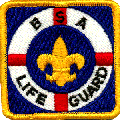BSA Lifeguard Award
This Award is meant for Scouts BSA.
Discontinued - this award has been discontinued in 2024.

The BSA Lifeguard patch is worn on the right side of your BSA swimsuit, not on your scout uniform.
Download the Application Form
PREREQUISITES:
Before doing requirements 6 through 25, complete the following:
- Submit proof of age. You must be at least 15 years old to participate.
- Submit written evidence of fitness for swimming activities (signed health history).
- Swim continuously for 550 yards, in good form: using the front crawl or breaststroke, breaststroke or a combination of either, but swimming on the back or side is not allowed.
- Immediately following the above swim, tread water for two minutes.
- Starting in the water, swim 20 yards using a front crawl or breaststroke, surface dive 7 to 10 feet, retrieve a 10-pound object, surface, swim on your back with the object 20 yards back to the starting point, and exit the water, all within 1 minute, 40 seconds.
REQUIREMENTS:
Complete the following requirements within a 120-day period:
- Show evidence of current training in American Red Cross First Aid and American Red Cross CPR/AED for the Professional Rescuer or equivalent.
- Show evidence of current training in the BSA online module for Safe Swim Defense.
- Attend and actively participate in all activities, presentations, and skill sessions involving lifeguard behavior, duties, responsibilities, surveillance, intervention and water rescue as prescribed in the BSA Lifeguard Instructor Manual.
- Demonstrate reaching assists from the deck using an arm, a rescue tube, and a pole.
- Demonstrate throwing assists using a throw bag and a ring buoy with line attached. Throw each device such that the line lands within reach of an active subject 30 feet from shore.
- Demonstrate:
- Rescue of an active subject in deep water using a rescue board, kayak, rowboat, canoe, or other rescue craft that would be available at your local facility.
- Repeat for a passive subject.
- Demonstrate an entry and front approach with a rescue tube to an active subject in deep water 30 feet away from shore. Position the rescue tube to support the subject and then assist the subject to safety, providing direction and reassurance throughout.
- Demonstrate an entry and rear approach with a rescue tube to an active subject in deep water 30 feet away from shore. Secure and support the subject from behind and then move the subject to safety, providing direction and reassurance throughout.
- Demonstrate use of a rescue tube to assist two subjects grasping each other. Secure, support, and reassure both subjects. With the assistance of a second guard, calm and separate the subjects and move them to safety.
- Demonstrate both front and rear head-hold escapes from a subject's grasp.
- Demonstrate an entry and front approach with a rescue tube to a face-down passive subject 30 feet away at or near the surface in deep water. Use a wrist roll to position the subject face-up on the rescue tube, tow them to safety, and remove them from the water with assistance within 90 seconds. Immediately perform a primary assessment and demonstrate one-person CPR for three minutes.
- Demonstrate an entry and rear approach with a rescue tube to a face-down passive subject 30 feet away at or near the surface in deep water. Position the subject face-up, tow them to safety, and remove them from the water with assistance within two minutes. Immediately perform a primary assessment and demonstrate two-person CPR for three minutes.
- In shallow water, demonstrate in-water ventilation of an unconscious subject when prompt removal from the water is not possible. Open the airway, position the mask, and simulate ventilations.
- Demonstrate an entry and approach with a rescue tube for use when a passive subject is submerged face-down at or near the bottom in 6 to 8 feet of water. Bring the subject to the surface and tow to the nearest point of safety.
- Remove a subject from the water using each of the following techniques in the appropriate circumstances with the aid of a second rescuer:
- Extrication at the edge of a pool or pier using a backboard
- Walking assist
- Beach drag
- Participate in multiple-rescuer search techniques appropriate for a missing subject in murky water:
- Line search in shallow water
- Underwater line search in deep water without equipment
- Underwater line search in deep water with mask and fins
- Demonstrate in-line stabilization for a face-down subject with suspected spinal injury in very shallow water (18 inches or less).
- Demonstrate in-line stabilization for a suspected spinal injury in shallow water (waist to chest deep):
- For a face-up subject
- For a face-down subject
- Demonstrate in-line stabilization for a suspected spinal injury in deep water, swim the subject to shallow water, confirm vital signs, and with the assistance of three others, remove the subject from the water using a backboard with straps and a head immobilization device.
- Correctly answer 80 percent of the questions on the BSA Lifeguard knowledge test covering the course material. Review any incomplete or incorrect answers.
- Serve as a lifeguard, under supervision, for at least two separate BSA swimming activities for a combined time of two hours. Afterward, discuss the experience with the lifeguarding instructor.
Click one to vote:
Scouting 2026 - Ask a Question - Add Content
Just for Fun: Socializing merit badge




This site is not officially associated with Scouting America
Find more Scouting Resources at www.BoyScoutTrail.com



Follow Me, Scouts
Recent Comments